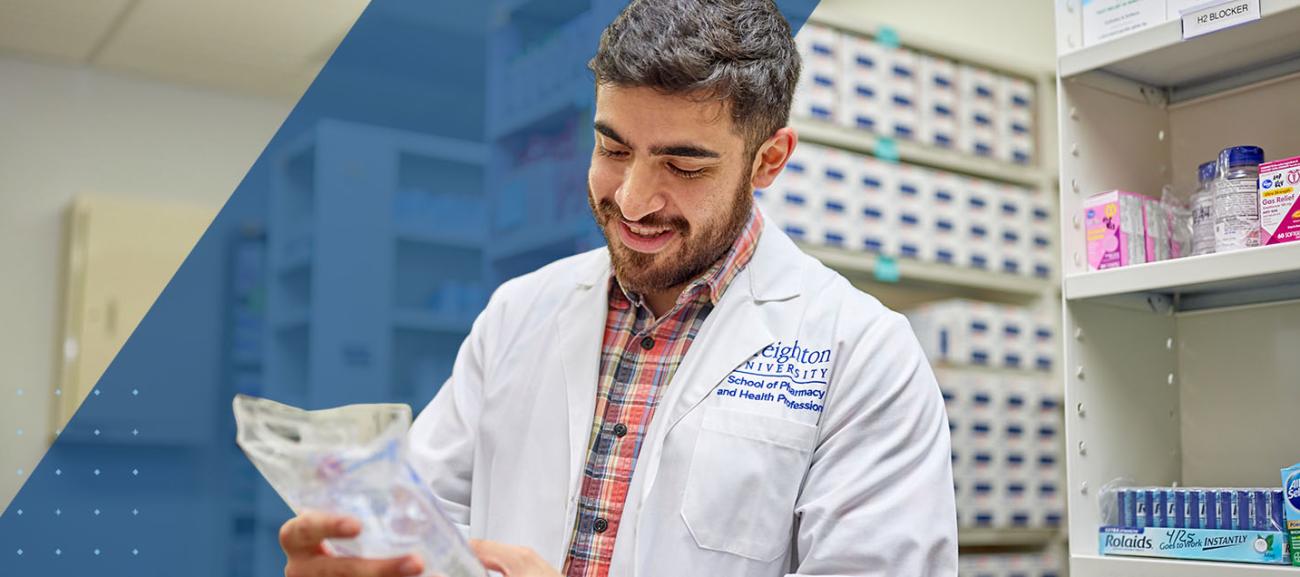
4 types of pharmacists you may not know about

When you think of a pharmacist, you probably imagine a friendly, knowledgeable person dispensing medication from behind the counter at a hospital or your local pharmacy. These two types of pharmacists are the most common and widely recognized, and it’s easy to see why.
Community pharmacists provide essential medication services to the public, and hospital pharmacists ensure patients receive safe and appropriate therapeutic drugs during their stay.
According to the U.S. Bureau of Labor Statistics (BLS), 40 percent of pharmacists are employed in community pharmacies and drug stores, while 27 percent work in state, local and private hospitals. However, this field contains many rewarding career paths that aren’t as well-known but are still crucial for improving patient care, creating knowledge and advancing the future of healthcare.
Join us as we explore four fascinating types of pharmacists you may not know, with insight from Nicole White, associate professor in the pharmacy program at Creighton University.
4 fascinating pharmacist jobs to consider
With a Doctor of Pharmacy (PharmD) degree in hand, you can pursue any of the positions below, though some will require additional training.
“Students are often surprised by how many career opportunities there are for pharmacists,” White says. “I think this has to do with lack of personal exposure to many of the roles pharmacists play behind the scenes of traditional patient care settings.”
From industry innovators to specialized patient care providers, learn more about four types of pharmacists making a positive difference in the lives of many.
1. Ambulatory care pharmacist
Ambulatory care pharmacists are dedicated to helping people manage complex medication regimens and chronic illnesses. They work exclusively in outpatient settings like clinics, physicians’ offices, surgical centers and urgent care facilities.
This specialty is more clinical in nature and involves a lot of decision-making, consultation, follow-up and patient education. Other examples of ambulatory care pharmacist duties include:
- Working with patients and caregivers to manage chronic conditions such as diabetes, high blood pressure, asthma, arthritis, Crohn’s disease and many more.
- Conducting comprehensive medication reviews and medication therapy management
- Collaborating with interprofessional care teams that include doctors, nurses, nurse practitioners, therapists and other healthcare providers
- Monitoring patients’ medication adherence, assessing outcomes, and recommending adjustments
“Ambulatory care pharmacists are highly valuable in clinical settings,” White says. She adds that the American Medical Association has recognized pharmacists as important contributors to patient care and developed a toolkit with resources to help practices embed pharmacists into their patient care teams. “This is a pharmacy role we are seeing expand and hopefully more patients with interface with a pharmacist at their doctor’s office”.
Becoming an ambulatory care pharmacist often requires additional training and certification by the Board of Pharmacy Specialties.
2. Pharmaceutical industry pharmacist
As you might expect, pharmacists work across every single stage of the drug development process and all sectors of the pharmaceutical industry. Some specific examples include:
- Research and development pharmacists: These professionals are responsible for testing and creating new medications. They work with other scientists in a “bench lab” environment to identify molecules that could potentially have therapeutic applications. They also help carry out clinical trials and assess the safety and efficacy of new drugs.
- Quality control pharmacists: These individuals play a critical role in ensuring the nation’s drug supply is safe, high-quality and consistent with regulatory standards. They frequently test raw materials and finished products, in addition to monitoring the manufacturing process.
- Regulatory affairs: Pharmacists who work in regulatory affairs are experts in navigating the complex landscape of highly regulated and controlled pharmaceuticals. They collaborate with scientists, regulatory authorities, marketers, sales staff, prescribing healthcare providers, executives and other stakeholders to make sure all the company’s activities and products are in compliance.
- Medical affairs pharmacists: These professionals act as liaisons between healthcare providers and drug developers. They provide medical and scientific information to physicians to help them understand all of the properties, applications, and counter-indications of medications. They also conduct education and training programs and participate in industry conferences and symposiums.
- Pharmaceutical sales and marketing: These fields also require support from industry pharmacists. The advertising landscape for medications is highly regulated, and companies can face fines and sanctions for missteps. Pharmacists work closely with marketing teams to develop promotional materials that accurately describe a product’s features and benefits.
White notes that pharmacy students who are interested in industry-oriented work often seek out fellowships at pharmaceutical companies after graduation. These are typically one- or two-year commitments where new grads are exposed to different opportunities within the enterprise and will often get hired internally upon completion.
“It’s a full-time job but you are learning and getting hands-on training, and the skills you develop make you more competitive for full-time employment in the pharmaceutical industry,” White explains.
3. Nuclear pharmacist
According to the National Cancer Institute, about half of all cancer patients receive external radiation therapy wherein beams of radiation are sent into a tumor from outside the body. This form of nuclear medicine is what most people are familiar with, as it has been used for over 100 years.
Nuclear pharmacists, on the other hand, are dedicated to working with a new class of drugs called radiopharmaceuticals which contain isotopes that are used for diagnostic imaging (e.g., PET scans), therapeutic treatments and research. These revolutionary drugs are delivered through the bloodstream and destroy tumors from the inside out by targeting molecules on the surface of cancer cells.
Nuclear pharmacist duties include:
- Handling, preparing, compounding and dispensing radioactive materials used in medicine
- Conducting quality control tests to ensure accuracy and safety of the dosage and determine the purity of the drug
- Following strict regulatory guidelines for handling hazardous chemicals and specimens
- Carrying out research and development of new radiopharmaceutical drugs
Because nuclear pharmacists usually treat cancer patients, they must work closely with a team of physicians, radiologists and other health professionals to provide holistic care. To become a nuclear pharmacist, you must complete additional didactic and practical training and get certified by the Board of Pharmacy Specialties.
4. Academic pharmacist
As a pharmacy professor, you get the chance to put your knowledge to work training and developing the next generation of pharmacists. Many academics are teacher-practitioners, who split their time between working in a pharmacy or clinical setting, lectures and/or research.
“I never intended to become an academic pharmacist when starting pharmacy school, but through guidance from my faculty mentors and completing an academic rotation, I found my calling,” White shares. “I love getting to know my students, helping them find their pharmacy niche, and watching them grow professionally- even beyond graduation. Being an academic pharmacist also allows you to pursue your unique interests through teaching, research and practice in your area of expertise.”
While the exact duties will vary depending on your interests and specialties, academic pharmacists typically carry out tasks like:
- Working with students in laboratory settings and guiding them through hands-on practice with equipment, drug preparation techniques, testing, safety protocols and more.
- Developing curriculum, planning content and lesson plans, and delivering lectures
- Supervising students during experiential learning rotations as a preceptor
- Engaging in research to advance the field of pharmacy, conducting studies, publishing articles and presenting at conferences
Skilled teachers with a wealth of professional experience are needed to educate the next generation of pharmacists. Pharmacy professors often act as mentors for students and must be comfortable taking on advisory roles.
Find a fulfilling pharmacy career
It’s clear that a PharmD program can open the door to several types of pharmacist careers. If you’ve already started your pharmacy degree but haven’t yet decided on a career path, don’t stress. A high-quality program will give you plenty of opportunities to explore options while you’re still in school. White remarks that experiential education is one of the great strengths of Creighton University’s pharmacy curriculum.
“From the very first semester students are shadowing and talking to pharmacists and getting exposure to different kinds of practice,” White says. The hands-on and clinical experience gets progressively more intense throughout pharmacy school, culminating in eight 5-week advanced rotations during the fourth and final year.
Our innovative, nationally-ranked PharmD program is offered in three distinct modalities: the Omaha Pathway, the Distance Pathway and the Phoenix Hybrid Pathway.












